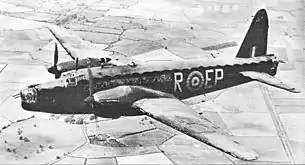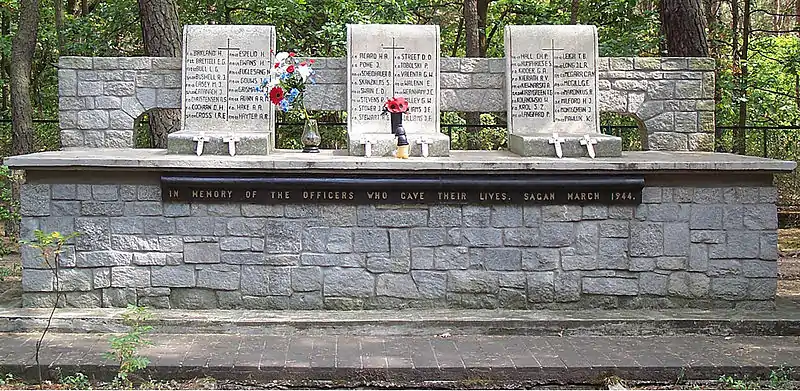Antoni Kiewnarski
Antoni Wladyslaw Kiewnarski (26 January 1899 – 31 March 1944) known as “Tony” was a Polish Vickers Wellington bomber “Observer and Captain” flying from England when he was taken prisoner during the Second World War. He is notable for the part he took in the 'Great Escape' from Stalag Luft III in March 1944 and as one of the men recaptured and subsequently shot by the Gestapo.
Antoni Kiewnarski | |
|---|---|
 | |
| Birth name | Antoni Wladyslaw Kiewnarski |
| Nickname(s) | Tony |
| Born | 26 January 1899 Moscow, Russia |
| Died | 31 March 1944 (aged 45) Jelenia Gora formerly Hirschberg |
| Buried | Poznan Old Garrison Cemetery, Poland |
| Allegiance | |
| Service/ | |
| Years of service | 1917–1944 |
| Rank | Flight Lieutenant and Major |
| Service number | P.0109 |
| Unit | No. 305 Polish Bomber Squadron |
| Battles/wars | World War I Polish-Soviet War World War II |
| Awards | Mentioned in Despatches |
Early life
Kiewnarski was born in Moscow, Russia. He enlisted in the Polish Army in August 1917 and served with distinction in three wars, World War I, the Polish-Soviet War and World War II transferring to the Polish Air Force and rising through the ranks to senior sergeant and later commissioned officer.[1]
War service
.svg.png.webp)
After the German and Soviet invasions of Poland in September 1939 Kiewnarski travelled to France and later to England to continue the fight against the occupiers of Poland.[2] In England Kiewnarski continued to fly and became a flight lieutenant in the Free Polish Air Force serving with No. 305 Polish Bomber Squadron flying Vickers Wellington bombers from RAF Ingham. He was an “Observer” (the aircrew role of Navigator /Bomb Aimer) and in command of the aircraft and its crew. He survived a serious crash on the night of 17 – 18 April 1942 when his crew were flying Vickers Wellington (serial number W5566) tasked with bombing Hamburg.[3] They had to drop their bombs in the area of Tierschelling because of engine trouble and had to make their return flight on only one engine. While attempting to land at RAF Lindholme the aircraft collided with another Wellington which was parked on the ground. Five of the Polish crew in W5566 were slightly injured and the tail gunner escaped injury.[4]

Prisoner of war
Kiewnarski was in command of Vickers Wellington Mark IV (squadron codes SM-D, serial number “Z1245”) on the night 27 – 28 August 1942 attacking the German target at Kassel. His aircraft was shot down by a German night fighter near Eindhoven when three of the crew were killed. He and his wireless operator sergeant Frankowski were captured by the Germans, Frankowski was wounded and after treatment managed to escape and return to England. Kiewnarski went straight into the prison camp system as prison of war number 42,801.[5] He ended up in prisoner of war camp Stalag Luft III in the province of Lower Silesia near the town of Sagan (now Żagań in Poland). In prison camp he was regarded as the elder statesman of the Polish prisoners.[6]
'Great Escape'
Kiewnarski was one of the 76 men who escaped the prison camp on the night of 24–25 March 1944 in the escape now famous as "the Great Escape". The initial groups out of the tunnel were those who needed a head start in order to get to the local railway station and catch their appropriate trains. He was in the first group of “walkers” who followed, they were led by Williy Williams and posed as a band of lumber mill workers on leave and included Australian Rusty Kierath, Canadian Jim Wernham and Pole Kaz Pawluk.

In a filthy cold night they headed east towards the railway lines and then south to Tschiebsdorf railway station where Jerzy Mondschein used a forged travel pass to buy tickets for the group of twelve on the 6AM train to Boberrohrsdorf three hours south where they split up.[7] Kiewnarski and Kaz Pawluk arrived in Hirschberg (now Jelenia Gora ) but while walking through the town during the afternoon were arrested and interrogated in the town police station before being held in the local jail with other recaptured escapees.[8][9][10]
On the morning of 29 March 1944 Jim Wernham and Nick Skantzikas were removed from the cell and then during the afternoon Doug Poynter and Pop Green. Two days later on the morning of 31 March 1944 Kaz Pawluk and Kiewnarski were taken away. They were shot near Hirschberg (now Jelenia Gora )[11][12][13][14]
Kiewnarski was one of the 50 escapers who had been listed by SS-Gruppenfuhrer Arthur Nebe to be killed[15] so was amongst those executed and murdered by the Gestapo. The place he was cremated is unknown.[16][17][18] His remains are now buried in part of the Poznan Old Garrison Cemetery where his headstone shows the rank major.[19][20]
Kiewnarski is commemorated on the Polish Air Force Memorial at Northolt, Middlesex.[21]
His name was on the list of murdered officers which was published by newspapers on 20 May 1944.[22]
| Nationalities of the 50 executed |
Awards
His conspicuous bravery as a prisoner was recognized by a Mention in Despatches as none of the other relevant decorations then available could be awarded posthumously.
Other victims
The Gestapo executed a group of 50 of the recaptured prisoners representing almost all of the nationalities involved in the escape. Post-war investigations saw a number of those guilty of the murders tracked down, arrested and tried for their crimes.[23][24][25][26]
References
- Vance (2001), p. 127
- Sikorksi Institute, London. Polish Air Force index card – A Kiewnarski
- Chorley (1994), p.74
- Yorkshire aircraft website - Kiewnarski
- Chorley (1994), p.195 and 312
- Vance (2000), p.127
- Carroll (2004), p.190
- Andrews (1976), p.47-48
- Vance (2000), p.237 and 255
- Carroll (2004), p.190-191 and p.195
- Vance (2000) p.256
- Andrews (1976), p.186-189
- Read (2012), p.242
- "Stalag Luft III: The Fifty". Pegasus Archive. Retrieved 22 September 2015.
- Andrews (1976), p.34
- Kochanski (2012), p.497
- Read (2012), p.129 and 132
- Andrews (1976), p.48 and 206
- Antoni Kiewnarski headstone
- Find-a-grave - Antoni Kiewnarski
- Northolt Memorial PDF file – A W Kiewnarski
- Western Morning News, Dundee Courier, Yorkshire Post, etc. 20/05/1944
- Read (2012), pp.294–297
- Vance (2000), p.310
- Andrews (1976), p.182-183 and p.186-7
- Yale Avalon Project-War Crimes Trial Part 8 – victim Kiewnarski
- Bibliography
- William R Chorley (1994). RAF Bomber Command Losses, Volume 3. Midland Counties. ISBN 978-0-904597-89-9.
- Andrews, Allen (1976). Exemplary Justice. Harrap. ISBN 0-245-52775-3.
- Kochanski, Halik (2013). The Eagle Unbowed: The Poles and the Polish in WW2. Penguin. ISBN 978-1846143588.
- Ash, William; Foley, Brendan (2005). Under the Wire: The Wartime Memoir of a Spitfire Pilot, Legendary Escape Artist and 'Cooler King'. Bantam. ISBN 978-0-593-05408-6.
- Brickhill, Paul (2004). The Great Escape. W.W. Norton & Company. ISBN 978-0-393-32579-9.
- Burgess, Alan (1990). The Longest Tunnel: The True Story of World War II's Great Escape. Naval Institute Press. ISBN 978-1-59114-097-9.
- Clark, Albert P. (2005). 33 Months as a POW in Stalag Luft III: A World War II Airman Tells His Story. Fulcrum Pub. ISBN 978-1-55591-536-0.
- Durand, Arthur A. (1989). Stalag Luft III: The Secret Story. Patrick Stephens Limited. ISBN 978-1-85260-248-2.
- Feast, Sean (2015). The Last of the 39-ers. Grub Street. ISBN 978-1909166158.
- Herington, John (1963). Air Power Over Europe, 1944–1945. Australia in the War of 1939–1945. Series 3 – Air. Volume IV (1st ed.). Canberra: Australian War Memorial. OCLC 3633419.
- Read, Simon (2012). Human Game: The True Story of the 'Great Escape' Murders and the Hunt for the Gestapo Gunmen. Berkley. ISBN 978-042525-273-4.
- Carroll, Tim (2004). The Great Escapers. Mainstream Publishing. ISBN 1-84018-904-5.
- Vance, Jonathan F. (2001). A Gallant Company. Pacifica Military. ISBN 978-0-935-55347-5.
External links
- Project Lessons from the Great Escape (Stalag Luft III), by Mark Kozak-Holland. The prisoners formally structured their work as a project. This book analyses their efforts using modern project management methods.